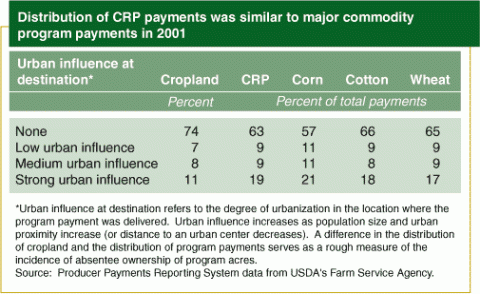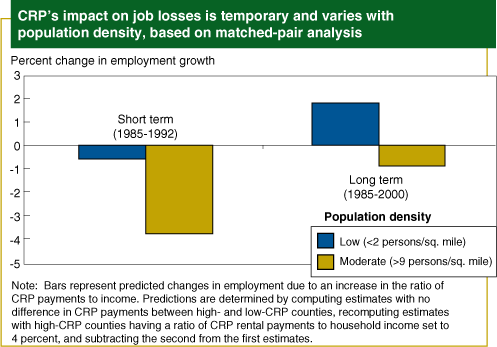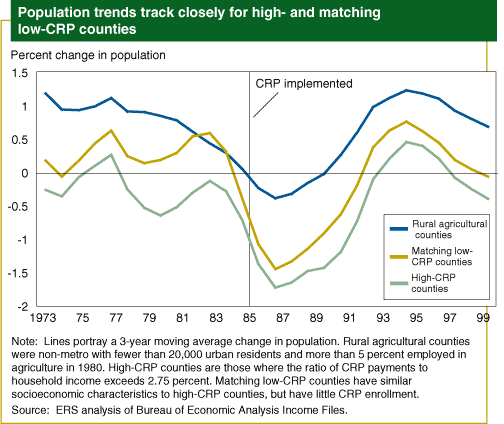Farmland Retirement's Impact on Rural Growth
- by Patrick Sullivan, Daniel Hellerstein, David McGranahan and Stephen Vogel
- 7/1/2006
Conventional wisdom holds that efforts to protect natural resources and the environment affect resource-related jobs, and consequently the economies of nearby communities. Recent ERS analysis of the impact of the Nation’s largest farmland retirement program— the Conservation Reserve Program— on rural economic growth suggests otherwise.
The Conservation Reserve Program (CRP) aims to reduce soil erosion, improve air and water quality, enhance wildlife habitat, preserve the productive capacity of the Nation’s farmland, and support farm income by taking land out of production for 10-15 years and putting it into conservation uses. Landowners and farm operators have voluntarily enrolled over 35 million acres of highly erodible and environmentally sensitive farmland in the program. In return for planting qualifying land to grasses, trees, and other protective vegetative cover, enrollees receive an annual rental payment, are reimbursed for roughly half the cost of establishing approved ground cover, and may be eligible for other incentive and maintenance payments. The program provides a stable source of income to participants and produces a wide range of environmental benefits. But by retiring farmland, it also reduces local demand for farm inputs, marketing services, and labor. To limit the local economic impact of taking land out of production, no more than 25 percent of a county’s cropland can normally be enrolled in the CRP without formal approval to exceed this cap. Nonetheless, the program is often blamed for the loss of farm-related jobs and the depopulation of nearby communities that provide agricultural and retail services.
ERS analyses of CRP enrollment patterns and employment/population trends indicate that high levels of CRP enrollment tend to reduce local job growth by a small but statistically significant amount in the years immediately following cropland retirement. Farm and farm-related employment is likely to decline as farmland is taken out of production. Over time, however, local economies adjust to changing business opportunities, and employment trends return to levels typical of similar areas with little or no CRP enrollment. In addition, nonfarm output and employment may increase due to CRP’s impact on farm household income and the CRP-enhanced recreational opportunities created. Contrary to popular belief, no statistically significant evidence was found that CRP results in a systematic loss of population, even among counties with high enrollments. Thus, the conservation benefits attributable to the CRP do not appear to come at the expense of a permanent slowdown of local job growth or to systematically threaten the survival of rural counties.
Farm and Nonfarm Responses to CRP Largely Offset in Short Term
Past studies have predicted the employment impact of enrolling cropland in the CRP. They generally conclude that CRP enrollment reduces farm and nonfarm employment, particularly in areas where enrollment is high. ERS recently estimated the economywide impact of allowing all CRP contracts to expire, freeing enrolled acreage to return to production. Consistent with previous research, allowing CRP land to return to production would increase farm employment, but the impact on nonfarm jobs varies considerably by region and depends on underlying assumptions.
Based on market conditions in 2000, only about half of the land enrolled in CRP would be expected to return to crop production in the short term if CRP contracts expired. The remainder would likely go into pasture or be left undisturbed. Holding prices constant, roughly $3 billion in additional farm commodities could be produced on CRP land coming back into production. (However, the resulting increase in crop production could lower affected farm commodity prices slightly, resulting in a net decline in farm income nationwide.) Of course, the environmental benefits attributed to CRP would likely decline as land reenters production. For example, as wildlife habitat degrades and water quality deteriorates, outdoor recreational expenditures in rural America could decline by as much as $300 million annually.
As these CRP-induced changes in production and spending work their way through the economy, nonfarm jobs would be created or lost. Land brought back into production would increase local demand for farm-related goods and services (farm inputs, labor, marketing and transportation services, etc.), leading to job growth in these industries. But reduced outdoor recreational spending could lead to job losses in other industries. And as income is redistributed from farm households to other sectors of the economy, shifting demand for consumer goods and services could lead to other job changes as well. Each of these changes affects production, income, and consumption.
Nationally, the economic effects of allowing CRP land to return to production are expected to be very small (less than one-tenth of 1 percent), with positive and negative effects within particular industries and regions largely canceling each other out. But the effects could be noticeable in areas of the country where CRP enrollment is high. By focusing on possible output, employment, and income effects in three regions having significant CRP enrollments, the regional implications of allowing all CRP contracts to expire become clearer.
ERS researchers assessed the implications of allowing CRP contracts to expire using two sets of assumptions. In the traditional approach, CRP enrollment is assumed to have no influence on outdoor recreational expenditures or farm commodity prices. A newer approach developed by ERS allows CRP enrollments to influence recreational spending and commodity prices, both of which tend to counter CRP’s impact on farm output and employment with opposite changes in nonfarm output and employment. As a result, the upper bound of the predicted impacts from allowing CRP land back into production (based on traditional assumptions) is often positive while the lower bound (reflecting recreational and price effects) is often negative.
The Northern Plains and the Southern Plains regions, as defined here, each have slightly more than 8 million acres of cropland enrolled in CRP, while enrollment in the southwestern Corn Belt is less than 2 million acres. Despite similar CRP acreage, the expected outcomes of eliminating CRP contracts in the Northern and Southern Plains are very different. The Northern Plains is more geographically isolated, has a lower population density, and is more dependent on agriculture than the other two regions. As a result, the output, employment, and household income responses to allowing CRP land to return to production in the Northern Plains are estimated to be roughly three times greater (in terms of percentage change under both sets of assumptions) than in the Southern Plains. Part of these differences is due to the larger dollar size of the economy in the Southern Plains. However, when impacts are measured in absolute rather than percentage changes, the responses in the Northern Plains are still twice the size of the those in the Southern Plains. This suggests that CRP’s impact on local economies is sensitive to local conditions.
In addition, there are likely to be winners and losers within local economies. While aggregate output and jobs are estimated to increase at least slightly in all three regions if CRP contracts expired under both sets of assumptions, this outcome is largely due to gains in the farm sector. However, if commodity prices and recreational expenditures are allowed to adjust, nonfarm output and employment are estimated to decline if CRP contracts expired, as would aggregate household income.
CRP’s Job Impacts Fade With Time
Previous results imply that farm and farm-related employment and output are lower than they would be in CRP’s absence. But CRP’s impact on the nonfarm economies of the three multistate regions analyzed appears small (never over 1.5 percent) and may be positive or negative, depending upon assumptions about recreational spending and commodity prices.Another approach to estimating CRP’s local economic impacts is to examine what actually happened before and after CRP was implemented in 1986. Doing so illustrates how local businesses and entrepreneurs reacted to changing economic opportunities as land entered the CRP.
To assess the local impact of high CRP enrollment, roughly 200 rural counties with over 20 percent of cropland enrolled in the CRP or where the ratio of CRP rental payments to total county household income exceeded 2.75 percent were identified. These “high-CRP” counties were then matched with counties that had little CRP enrollment but had similar pre-CRP socioeconomic conditions. By charting the economic course of high- and matching low-CRP counties following CRP’s implementation, any systematic effect of high CRP enrollment should become clear.
The results generally confirm previous analyses. In the years immediately after land was enrolled in the CRP, job growth in high-CRP counties was significantly lower than in comparable low-CRP counties. However, job growth is indistinguishable over the longer term (1985-2000). Either entrepreneurs were able to adapt to the changing opportunities that CRP offered (such as improved recreational opportunities) with time or CRP merely sped up economic adjustments that other rural communities experienced more gradually. In either case, CRP’s impact on local trends in job growth was not permanent.
One might expect land retirement programs to affect communities that serve as regional agricultural business service centers more than other communities. Population density was used as a proxy for whether a county is likely to include one or more agricultural service centers. For low-density counties (fewer than two persons per square mile), CRP made little difference in job growth over the short term and may have had a positive impact over the longer term (perhaps by keeping farmer participants in place who might otherwise have moved elsewhere as the farm sector continued its consolidation). For counties with slightly higher population densities (over nine persons per square mile), the pattern was very different. In the short term, high-CRP enrollment led to a nearly 4-percent decline in job growth. But over time, this discrepancy dissipated.
Together, the forward-looking economic impact simulations of CRP contract expirations and the backward-looking comparison of pre- and post-CRP economic trends suggest that, as farmland is taken out of production, job growth in high-CRP areas could initially suffer. However, these impacts appear to be temporary, and they vary widely depending on local economic conditions. In lightly populated areas, high CRP enrollment could support local job growth over the long term by helping program participants stay on their farms. In other areas, CRP’s impact on farm-related industries is severe enough to significantly slow total job growth or speed its decline over the short term. But even in these areas, job growth rebounds over the long term as growth in other industries replaces jobs lost by farm-related firms.
CRP Does Not Accelerate Population Loss
CRP is particularly popular in areas of the country that have long been prone to population loss. That observation, combined with CRP’s impact on farm-related employment and the belief that retired participants move elsewhere after enrolling their entire farms in the program, has led many to argue that high CRP enrollments can lead to depopulation, threatening the survival of nearby communities. It is commonly suggested that CRP could exacerbate rural population loss by allowing participants to take their farms out of production and move out of farming communities, thereby eliminating farm jobs and both farm-related and consumer service jobs in nearby communities.
Absentee landownership (as measured by the outflow of CRP funds from counties where farmland is enrolled) tends to be highest in high-CRP areas of the country. Using ERS’s farm resource regions, the Northern Great Plains, the Prairie Gateway, and the Mississippi Portal all lost 10 percent or more of the 2001 payments earned on their CRP land to enrollees residing elsewhere. But CRP participants seem to be vacating rural areas no more than other farmers. The distribution of CRP payments among counties classified by degree of urbanization is very similar to the distribution of commodity payments for the corn, cotton, and wheat programs. Thus, payment flows more likely reflect pre-existing landownership patterns than residential relocation by CRP participants.

Further analysis suggests that while the number of farms is declining nationwide, counties with high CRP enrollment had no more trouble attracting beginning farmers or retaining farm operators than did low-CRP counties with similar farm sectors. Thus, even high CRP enrollment does not systematically spur the loss of farm populations.
Finally, many counties with high CRP enrollment have experienced population loss since the program’s inception. However, the data also show that high-CRP counties were experiencing depopulation long before CRP’s implementation in 1986. This suggests that the program may be particularly attractive in areas that are struggling, perhaps because of a lack of off-farm employment opportunities or limited demand for cropland that would be leased or sold to other farm operators in the absence of CRP. But, does CRP exacerbate population problems?
Comparing population trends in high-CRP counties with trends in similar counties having little CRP enrollment highlights the lack of systematic differences that might be attributable to CRP. Once other factors—such as low population density, isolation from urban centers, and dependence on agriculture—are taken into account, CRP has no statistically significant effect on population trends over either the short or the long term. There may be specific cases where CRP enrollment had a positive or negative effect on population, but in general, CRP enrollment is unrelated to underlying population trends.
CRP and Farm Communities
CRP is now in its 20th year of operation. From its inception, concerns have been raised that by retiring millions of acres of cropland, the program could disadvantage farming communities already hard hit by farm sector consolidation and globalization. Clearly the CRP does not benefit everyone, and the conservation benefits enjoyed by society may come at the expense of a few industries and regions. Nonetheless, results of ERS analyses suggest that CRP does not come at the expense of longrun economic growth in nearby communities. Even high levels of CRP enrollment have only a modest impact on total county employment, and this impact is relatively short lived. ERS simulations suggest that, in the longer term, CRP enrollment may increase local nonfarm output and employment, and bolster household income if the program increases farm commodity prices and improves recreational opportunities. No statistically significant evidence was found that high CRP enrollments were associated with systematic population declines at the county level.
This article is drawn from:
- Conservation Programs. (n.d.). U.S. Department of Agriculture, Economic Research Service.
- Bucholtz, S., Sullivan, P., Hellerstein, D., Hansen, L., Johansson, R., Koenig, S., Lubowski, R.N., McBride, W.D., McGranahan, D., Vogel, S. & Roberts, M. (2004). The Conservation Reserve Program: Economic Implications for Rural America. U.S. Department of Agriculture, Economic Research Service. AER-834.
- Feather, P., Hellerstein, D. & Hansen, L. (1999). Economic Valuation of Environmental Benefits and the Targeting of Conservation Programs: The Case of the CRP. U.S. Department of Agriculture, Economic Research Service. AER-778.
We’d welcome your feedback!
Would you be willing to answer a few quick questions about your experience?




